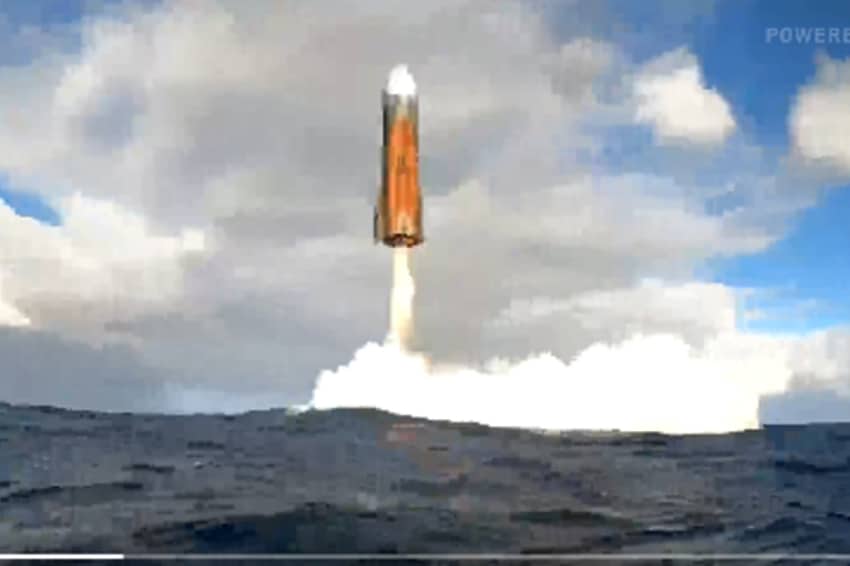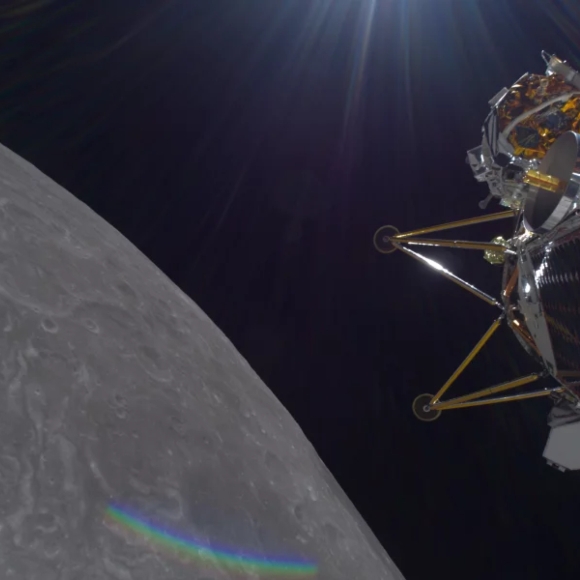Perfect 10! Impressive success for Starship on Its 10th Test Flight
On its tenth test flight, SpaceX’s giant Starship launch system successfully passed all key tests, including payload deployment in space, engine reignition in space, and execution of a controlled landing maneuver.
SpaceX has bounced back from a streak of setbacks with a milestone achievement: its revolutionary Starship launch system has successfully completed its tenth test flight. The spacecraft cleared all key objectives — deploying payloads in orbit, restarting its engine in space, reentering Earth’s atmosphere under challenging conditions, and executing a precise landing maneuver in the Indian Ocean. The Super Heavy booster also carried out a successful landing sequence over the sea.
The road to launch was not without hurdles. The attempt on Sunday, September 1, was scrubbed due to a fueling system malfunction, and the Monday, September 2, launch window was postponed by heavy cloud cover. But by Tuesday, September 3, the skies had cleared. At 6:30 p.m. local time, Starship lifted off right on schedule. The booster’s 32 of 33 Raptor engines performed nominally, propelling the vehicle into the sky. Roughly three minutes and forty seconds after liftoff, the booster separated from Starship in a hot-staging maneuver, with the spacecraft’s engines igniting before separation was complete.
Following separation, at about 80 kilometers altitude, the booster executed a scheduled flip before beginning freefall. This flip maneuver was designed to conserve fuel for the landing attempt. In this test, SpaceX did not intend to catch the booster with the launch tower, as had been tried in three previous test flights. Instead, it carried out a landing maneuver over water, simulating a scenario in which one of the three central engines used for landing fails. As the booster approached the ocean, it reignited most of its engines to slow down, then stabilized using two of its central engines and a third engine from the surrounding ring. The maneuver appeared highly successful – the booster hovered and stabilized at zero velocity above the Gulf of Mexico, not far from the launch site, before shutting down its engines and plunging into the water as planned.
Following separation, at an altitude of about 80 kilometers, the booster executed a planned flip maneuver before beginning its descent. The flip was intended to conserve fuel for the landing sequence. Unlike three earlier test flights, SpaceX did not attempt to catch the booster with the launch tower. Instead, it carried out a controlled splashdown landing maneuver over water, simulating the loss of one of the three central landing engines. As the booster neared the Gulf of Mexico, it reignited most of its engines to decelerate, then transitioned to stabilization using two central engines and one from the outer ring. The maneuver appeared highly successful: the booster hovered briefly at zero velocity above the water, just off the Texas coast, not far from the launch site, before shutting down its engines and plunging into the sea as planned.
Successful launch. Short video of Starship’s tenth test flight launch
Testing Under Harsh Conditions
The spacecraft, referred to by SpaceX as ‘Ship,’ continued as planned on a ballistic trajectory – an arcing flight path akin to that of a cannon shell. an arcing flight path akin to a cannon shell. In this profile, it did not enter Earth orbit but instead followed a course leading to reentry over the Indian Ocean, controlled or otherwise. About nine minutes after launch, Ship shut down its six engines at an altitude of 150 kilometers and a speed of 26,000 km/h. Roughly ten minutes later came the first major test: the payload bay door opened, and for the first time Starship deployed a payload in space — dummy satellites for the Starlink network. These flat, panel-like objects matched the size and shape of the company’s new-generation communication satellites. One by one, Starship expelled eight dummy satellite units. Like the spacecraft itself, they remained on suborbital paths, reentering the atmosphere and burning up as planned. The payload bay door then closed without issue.
First payload deployment in space from Starship: release of Starlink dummy satellites during Starship’s tenth test flight
The spacecraft’s next major test was restarting one of its six engines in space. About 38 minutes after launch, the engine fired for several seconds as planned, drawing cheers from employees watching the live broadcast at SpaceX’s Texas spaceport. Since this was a ballistic flight, engine burns were not required, but in future orbital missions such maneuvers will be critical — for controlled reentry and landing, and ultimately for crewed landings on the Moon and Mars, Starship’s intended destinations.
The central trial of the tenth test flight was the spacecraft’s reentry performance. This test deliberately subjected it to conditions harsher than those expected on operational missions, in order to assess resilience, functionality, and identify potential weaknesses. These conditions included reentry at a relatively shallow angle, which meant longer exposure to extreme heat, as well as intense mechanical loads during supersonic flight. The company also tested a new model of steering flaps for atmospheric control, which performed well despite sections burning and tearing under the intense heat. Several types of thermal protection tiles on the heat shield were also tested, with some areas intentionally left uncovered to identify weak spots. The spacecraft endured the trial and successfully completed all objectives.
At 1 hour and 6 minutes after launch, Starship reignited three engines just a few hundred meters above the Indian Ocean, balanced itself vertically over the waves, and executed a precise landing maneuver at its target site — before exploding as expected shortly after water contact, near a buoy-mounted camera positioned to capture the event.
Another notable achievement was continuous communication with the spacecraft throughout the mission, including uninterrupted video transmission even during the harshest reentry conditions. Beyond the visual impact, the real-time data from Starship’s many onboard cameras will provide SpaceX with valuable material for detailed performance analysis and for identifying faults and weaknesses.

Successful landing maneuver after a challenging test. Starship balances above the Indian Ocean at the end of the mission. Screenshot from SpaceX’s broadcast.
The Difficult Block
In recent months, SpaceX has faced a string of setbacks in Starship test flights. After six experimental flights in which the company advanced step by step — culminating in a successful ballistic flight and landing maneuver in the Indian Ocean — the company moved on to testing the enlarged and upgraded version of the spacecraft, known as Block 2. The first two Block 2 flights, Starship’s seventh and eighth overall, ended in midair explosions just minutes after liftoff. On the ninth test, in May of this year, Block 2 finally reached space but spun out of control due to a malfunction, reentered the atmosphere without orienting its heat shield downward, and was destroyed at an altitude of about 60 kilometers. To make matters worse, the spacecraft slated for the tenth test flight exploded during fueling ahead of a planned ground engine test about two months ago.
The successful test flight gives SpaceX some breathing room as it turns to the next challenges. CEO and founder Elon Musk congratulated employees in a tweet: “Great work by the SpaceX team!!” Still, despite the milestone, the company is behind schedule in developing the spacecraft. NASA has chosen Starship as the lunar lander for the first crewed missions of the Artemis program, but the first landing — already repeatedly delayed, not solely because of SpaceX — is now officially set for 2027. Doubts remain over whether Starship will be ready to carry humans by then, and even greater doubts over whether it will be prepared to land them on the Moon.
In future missions, SpaceX will need to demonstrate several key milestones: a full orbital flight of the spacecraft, in-orbit refueling — a cornerstone of its Moon and Mars mission architecture — and successful landings of both the booster and Starship itself. NASA Acting Administrator and Associate Administrator for Space Transportation Sean Duffy, congratulated SpaceX in a tweet, writing: “Congratulations to @SpaceX on its Starship test. Flight 10’s success paves the way for the Starship Human Landing System that will bring American astronauts back to the Moon on Artemis III..”
SpaceX has a long record of setting extremely ambitious schedules — and just as often missing them. A decade ago, Musk promised that Starship would land humans on Mars by 2024, when the vehicle was still far from its first launch. More recently, a Japanese billionaire canceled his agreement with SpaceX to fly tourists around the Moon aboard Starship, acknowledging that the project — originally planned for 2023 — was nowhere near realization.
None of this has stopped Musk from continuing to set bold timelines. Recently, he declared that SpaceX could send an uncrewed Starship to Mars as early as next year, with crewed missions potentially beginning as soon as 2029, though 2031 is considered more realistic. While Musk has a history of missing his own deadlines, it should be noted that SpaceX has achieved many goals once thought fantastical, even if later than promised. Starship is unlikely to land humans on the Moon within two years, but if the company continues advancing at its current pace, it is hard to imagine it not eventually reaching that milestone.



